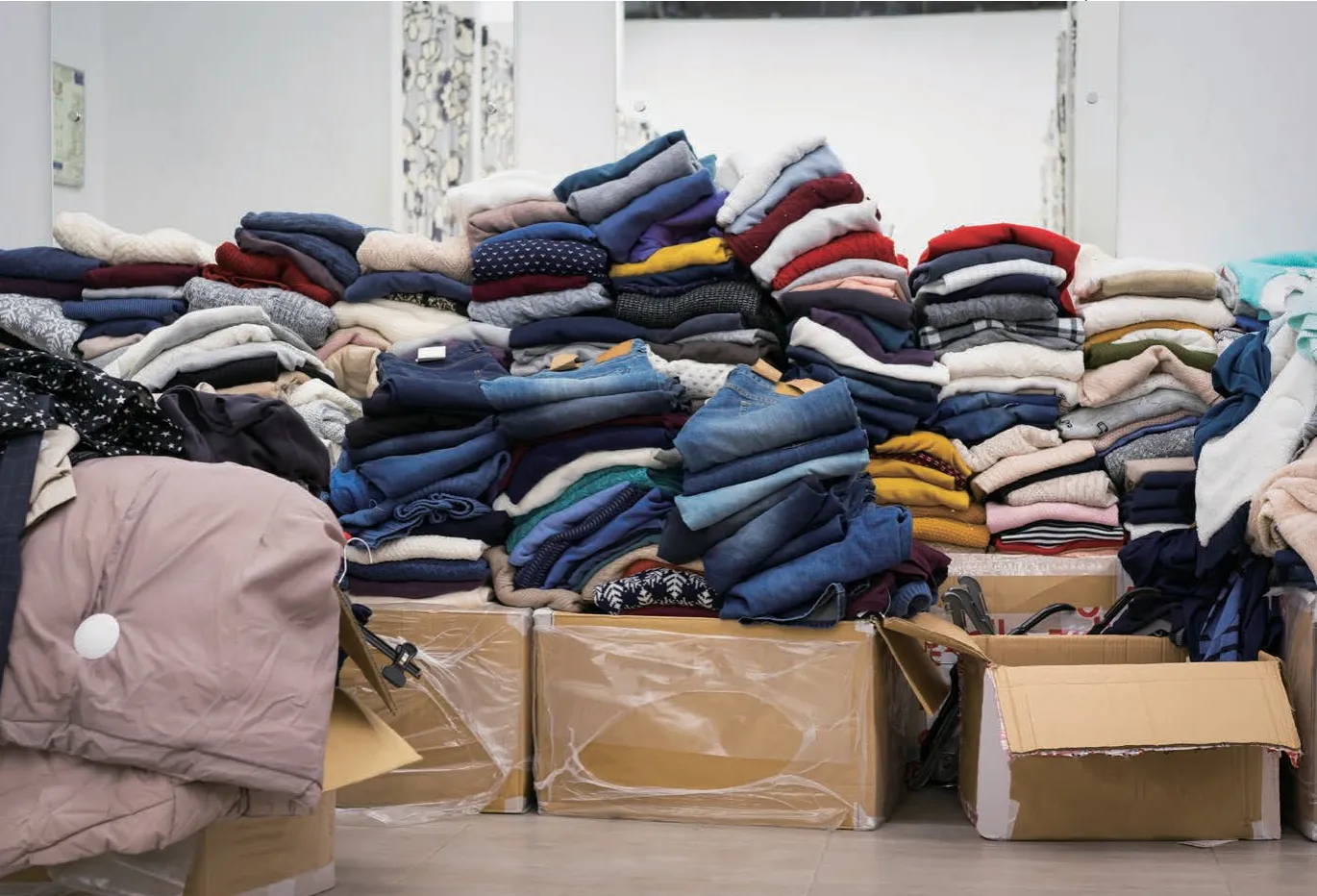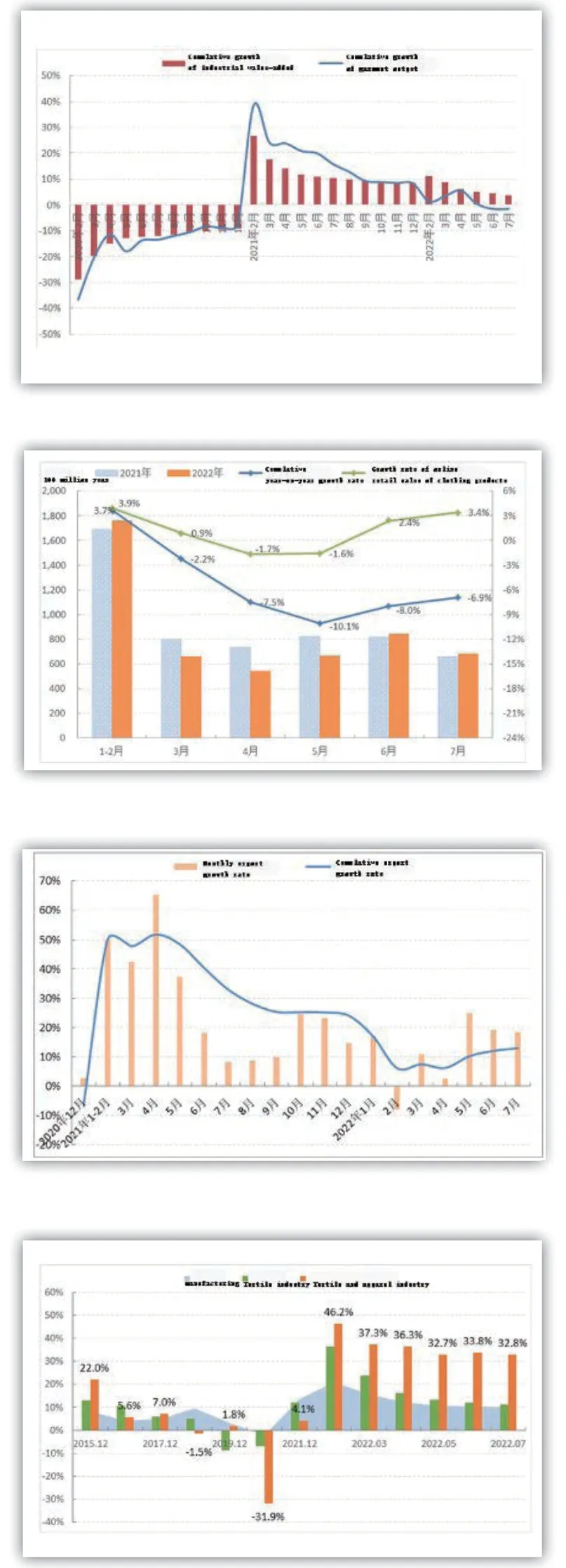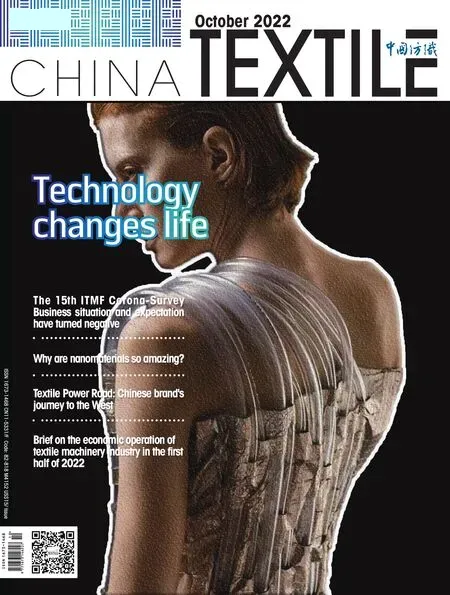China’s garment industry continues the trend of stability and recovery in first half year
Edited by Zhao Xinhua
In July,facing the more complicated international environment and the recurrence of the pandemic,China’s garment industry efforts to overcome problems such as the weakening demand,rising costs and inventory backlog.The overall operation of the industry continued the development trend of stabilization and recovery.In addition to small fluc—tuations in production,domestic sales continued to improve,exports grew steadily,investment increased well,and cor—porate profits maintained growth.However,it should also be noted that the rising risk of stagflation in the world economy has further increase the risk of weakening international mar—ket demand.The downward income expectation of domestic residents,the lack of consumer confidence,and the en—hancement of clothing optional and improved consumption attributes will inhibit the growth of clothing consumption to a certain extent.China’s garment industry sustained recovery still faces multiple risks and challenges.

Economic operation of garment industry
Garment production fluctuated slightly
In July,influenced by the pandemic and insufficient market demand,the industrial value—added of enter—prises above designated size in the garment industry turned negative again.From the cumulative data from January to July,the growth rate of industrial value—added and garment output of the garment industry showed a continuous downward trend,and the garment output had negative growth for two consecutive months,and the recovery rate of garment production slowed down signifi—cantly.According to the National Bureau of Statistics,in July,the industrial value—added of enterprises above des—ignated size in the garment industry decreased by 0.2%year—on—year;In the first seven months of this year,the industrial value—added of enterprises above designated size in the garment industry grew 3.6% year—on—year,6.8 percentage points slower than the same period last year and 0.8 percentage points slower than the January—June period.During the same period,the garment output of enterprises above designated size was 13.186 billion pieces,down 1.54% year—on—year,down 17.32 percent—age points compared with the same period last year,and the decline was 0.06 percentage points larger than in January—June.Among them,the woven clothing was 5.015 billion pieces,down 0.82% year—on—year;knitwear was 8.171 billion pieces,down 1.98% year—on—year.
The domestic market continues to recover
The growth of clothing sales slowed down in July due to unfavorable factors such as the spread of the pandemic and the high temperature and rainy weather in China,which greatly restricted residents’ social travel and business operations.However,in general,with the signifi—cant effect of pro—consumption policies and measures and the grad—ual smooth production cycle in various regions,the clothing sales in the domestic market have maintained a recovery trend,while the online retail is stable and rising,and the physical stores are doing well.According to the National Bureau of Statistics,the retail sales of clothing goods of units above designated size increased by 1.3%year—on—year in July,1.2 percentage points slower than in June.In the first seven months of this year,the retail sales of clothing goods in units above designated size totaled 513.07 billion yuan,down 6.9%year—on—year and 1.1 percentage points narrower than in the first six months of this year.Online retail sales of clothing maintained steady growth.The online retail sales of clothing products grew by 3.4%year—on—year in the first seven months of this year,1.0 percentage point faster than in the first six months of this year.The operation of physical stores has improved.According to the statistics of the China National Commercial Information Center,the retail sales of cloth—ing goods of the country’s key large retail enterprises decreased by 11.3% year—on—year from January to July,and the decline was 1.3 percentage points narrower than in January—June.

Exports maintained steady growth
In the January—July period,China’s garment exports maintained relatively rapid growth on the basis of a high base in 2021,showing strong resilience,supported by the continued recovery of interna—tional market demand.However,global inflation remains high,the risk of weakening demand in the international market is increasing,and the spread of the pandemic in China is not conducive to the normal production and operation of enterprises.In the next stage,China’s garment export will face greater pressure.According to China Customs,from January to July,the total export of clothing and cloth—ing accessories was $99.558 billion,up by 12.9% year—on—year,and the growth rate was 0.9 percentage points faster than in January—June.The export of clothing and clothing accessories in July was$19.638 billion,up 18.5% year—on—year.
The export volume and price of knitted garments rose,and the unit price of woven garments increased significantly.According to China Customs,from January to July,the number of garments exported was 18.49 billion pieces,up 5.0% year—on—year,and the average unit price of ex—ports was $4.45,up 14.6% year—on—year.Among them,the export volume and export unit price of knitwear both increased by 10.2% year—on—year;driven by the rise in raw material prices and the rapid growth in the export of garments with higher value—added for outdoor clothing,the export volume of woven gar—ments fell by 4.9% year—on—year,and the export unit price increased by 25.2%year—on—year.In the same period,China’s exports of gloves made of plastic and vulcanized rubber dropped by 67.3% year—on—year,and protective clothing made of chemical fiber dropped by 57.0% year—on—year.
China’s garment exports to major markets increased strongly,while the decline in exports to Japan continued to narrow.According to China Customs,from January to July,the amount of China’s garment export to the United States,the European Union and ASEAN was 23.99,20.65 and 8.54 billion U.S.dollars,respectively up 15.7%,21.8% and 29.3% year—on—year,the growth rate was 1.19,2.28 and 1.84 percentage points faster than in January to June;China’s garment export to Japan was $7.68 billion,down 1.3% year—on—year,3.89 percentage points narrower than in the January—June period.Garment ex—ported to the above four countries and regions accounted for 61.1% of China’s total clothing export,driving the growth of China’s garment exports by 10.0 percentage points.During the same period,China’s garment exports to coun—tries and regions along the Belt and Road,Latin America and Oceania continued to maintain rapid growth,with growth rates of 13.8%,35.8% and 18.0%,re—spectively,boosting the growth of China’s garment exports by 3.3,1.6 and 0.6 percentage points,respectively.In addition,China’s garment exports to Canada and Russia decreased by 7.2% and 29.1%,respectively,and garment exports to Africa decreased by 6.2%.
The growth rate of garment export in Zhejiang,Jiangsu and Shandong increased slightly,while that in Guangdong decreased significantly.From January to July,Zhejiang,Guangdong,Jiangsu,Shandong and Fujian,the top five garment exporting provinces,exported $72.1 billion,up 12.5% year—on—year,accounting for 72.4% of the country’s total garment export,down 0.3 percentage points from the same period last year.Among them,Zhejiang’s clothing export amounted to $20.74 billion,up 30.2% year—on—year;Jiangsu and Shandong’s clothing export increased by 13.9% and 20.1% year—on—year,1.1,0.5 and 2.2 percentage points faster than in January—June,respec—tively;Guangdong’s garment export fell by 5.0% year—on—year,1.3 percent—age points deeper than in January—June;Fujian’s garment exports grew 4.9%year—on—year,2.2 percentage points slower than in the January—June period.In addition,Shanghai’s garment exports recovered,growing 6.3 percentage points faster than in January—June.In the central and western provinces,the garment exports of Xinjiang,Jiangxi,Hunan and Sichuan continued to grow rapidly,with an increase of 69.7%,52.1%,71.5% and 66.4%,while the garment exports of Hebei and Hubei dropped 49.4% and 16.0% year—on—year,respectively.
Corporate performance grew under pressure
In July,the performance of China’s garment enterprises continued to recover.However,due to the pandemic,insuf—ficient demand,high costs and other factors,the growth rate of the main performance indicators of the garment industry slowed down,and the economic operation continued to be under pressure.According to the National Bureau of Statistics,from January to July,there were 13,106 enterprises above designated size (annual main business income of 20 million yuan or more) in China’s garment industry,achieving operating income of 815.937 billion yuan,with a year—on—year growth of 3.91%.The growth rate was 0.54 percentage points slower than in January—June,and 7.13 percentage points slower than the same period last year.The total profit was 37.003 billion yuan,up 3.96 percent year—on—year,0.04 percentage points slower than the January—June period and 5.86 percentage points slower than the same period last year.The industry’s operating efficiency has slowed,and rising costs have led to difficulties in improving profitability.From January to July,the finished goods turnover of enterprises above designated size in the garment industry was 11.83 times/year,down 5.76%year—on—year;the operating cost increased by 4.68% year—on—year,0.77 percentage points higher than the growth rate of operating revenue;the operating revenue per 100 yuan includes cost of 86.10 yuan,0.64 yuan more than the same period in 2021.Operating margin was 4.53%,unchanged from the same period in 2021.
Good growth in industry investment
In July,the investment in fixed assets in China’s garment in—dustry continued to maintain relatively fast growth,and the trend of industrial transformation and upgrading was obvious.Accord—ing to the National Bureau of Statistics,the completed investment in fixed assets in China’s garment industry grew by 32.8% year—on—year in the first seven months of this year,27.6 percentage points higher than in the same period of 2021,higher than the overall level of the textile industry and manufacturing industry by 21.7 percentage points and 22.9 percentage points.

Table 1 Main benefit indicators of the garment industry in January-July 2022
Analysis of the running trend of the garment industry
Garment exports face greater uncertainty
Affected by the recurrence of the pandemic in the countries,slowing global eco—nomic growth,worsening macro expectations,rising inflation and other factors,con—sumer confidence index in developed countries such as Europe and the United States continues to fall,consumption expectations decline,clothing wholesalers are facing high inventory pressure,and the possibility of external demand reduction will have an impact on China’s clothing export.The U.S.consumer confidence index fell to 51.1 in July,down from 80.8 a year earlier.Consumer confidence in the euro area continued to fall to —27 in July,the lowest level since 1985.Japan’s domestic consumption growth is sluggish,and the Bank of Japan (BOJ) lowered its forecast for fiscal 2022 growth from 2.9% to 2.4% in its economic and price outlook report on July 21.All this suggests that consumption in the world’s major advanced economies will be lower in the second half than in the first.With the normalization of the pandemic,apparel companies in the U.S.and Europe continue to promote the procurement diversification strategy and increase the volume of clothing purchases in India,Bangladesh,Vietnam and other countries for the sake of supply chain security and cost.In addition,influenced by the ban on Xinjiang cotton in the United States,overseas orders flow out of China,coupled with the high testing cost of Xinjiang cotton,domestic garment enterprises are relatively cautious in receiving orders.Facing the complex international environment,our cloth—ing export will face more severe challenges.
Slow recovery in domestic consumer demand
Due to the impact of the pandemic,overall domestic consumption is rela—tively weak,and residents’ consumption capacity and consumption level have declined significantly.The total retail sales of consumer goods in July increased by 2.7% year—on—year,still very sluggish.Residents who preferred to save more accounted for 58.3% in the second quarter,up 3.6 percentage points from the previous quarter,indicating a preference for saving rather than spending,ac—cording to a survey of urban savers in the second quarter of 2022 released by PBC on June 29.Under the influence of people’s consumption tendency,the recovery of domestic clothing consumption demand is relatively slow,and it has not returned to the pre—pandemic level,and the sales of some enterprises have fallen relatively significantly.In addition,the demand changes of the domestic clothing consumer market show diverse and complex characteristics.The demand of consumers is changing from quantity to quality,and higher requirements are put forward for the quality,professionalism and functionality of products.
Apparel companies move forward under pressure
The garment industry has been under great pressure from multiple factors such as the spread of the pandemic in China,the rise in raw material prices,and the weakening of short—term consumer demand.In the middle of July,a num—ber of listed clothing companies have released a half—year performance forecast,some of the enterprise performance drop significantly.The main reason is that affected by the pandemic,some physical stores cannot operate normally and retail customer flow is reduced.At the same time,high costs of raw materials,logistics and store operations have eaten into the company’s profits.In the face of rising manufacturing and export costs,small and medium—sized enterprises are under increasing pressure in their production and operation.Accord—ing to the National Bureau of Statistics,the mid—July PMI for small and medium—sized enterprises was 48.5 percent and 47.9 percent,respectively,down 2.8 percentage points and 0.7 percentage points from the previous month.With the arrival of“Golden September Silver October” consumption season,resi—dents’ consumption demand for autumn and winter clothing will promote market recovery,but at the same time,the market competition is also more intense.While launching high—quality,personalized and functional products,garment enterprises should constantly expand their sales channels,strengthen the connection and interaction with consumers through online and offline marketing activities,and improve their profitability.

